
Finches are small and pretty birds with conical beaks. Some are commonly kept as pets, while others come to backyard feeders.
Finches brighten the backyard with cheerful calls and pretty plumage. Which ones can you see in your backyard? How many finches live in parks, woodlands, and fields of the USA?
See this article for answers and to learn all about the finches that live in the USA!
Key takeaways:
- Finches are small, seed-eating songbirds, that can be identified by their stout bills and bright colors.
- There are 17 finch species living in North America.
- In the United States, House Finches are the most common species.
Types of Finches in the U.S.
Several beautiful finches live in the United States! No matter where you go birding, it won’t take long before you see some finches.
In the U.S., 17 members of the Finch family occur. Most are also common birds and fairly easy to see in appropriate habitats.
Related: Bird families & classifications
Nine other species have also occurred in the United States, but those birds are species like the Common Chaffinch and Brambling, Eurasian species that usually occur as vagrants to Alaska.
The regularly occurring finches in the USA live in a variety of habitats, including forests, parklands, and other semi-open habitats, and even deserts.
Rosy-finches also occur in cold, high mountain habitats, and several species breed in montane and northern boreal forests. These species include the Pine Grosbeak, White-winged Crossbill, and Evening Grosbeak.
Once in a while, to the delight of birders, these hardy birds migrate south of their main northern breeding grounds to more accessible regions.
House Finch
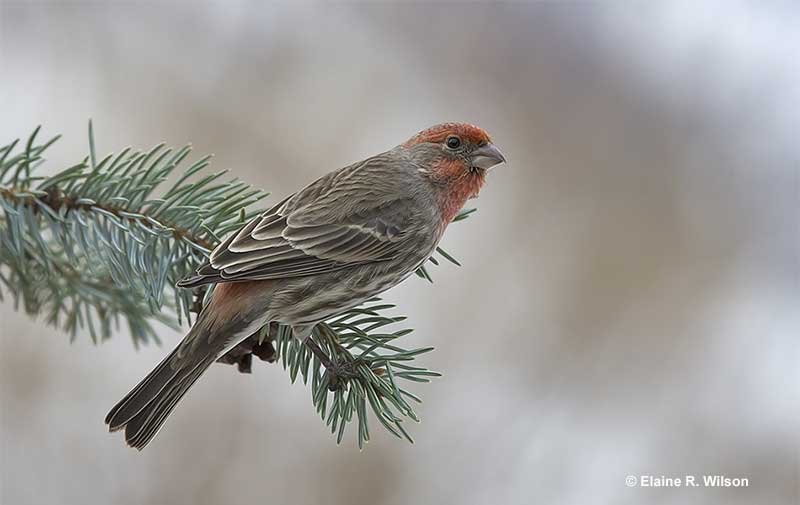
Scientific name: Haemorhous mexicanus
Size: 6 inches
Habitat: Deserts, parks, and urban areas.
House Finches are sparrow-like birds with two pale wing bars, and a smallish, slightly curved, conical beak. Males have red on their head, throat, chest, and rump. They also have some grayish around their eyes and on the back of their head, and gray-brown streaks on their back and sides.
Female House Finches are much duller, gray-brown birds with fine streaking on their heads, and thicker streaks on their underparts and back.
Like other finches, their tails have a shallow fork, and when they fly, the birds seem to “bounce” up and down as they move through the air.
These small birds are usually in pairs or small flocks, and can visit feeders. Historically, House Finches only lived in western North America and Mexico.
However, after being introduced to the eastern USA, the House Finch quickly became adapted to parks and urban areas. They spread throughout the lower 48 states and many areas in southern Canada.
Purple Finch
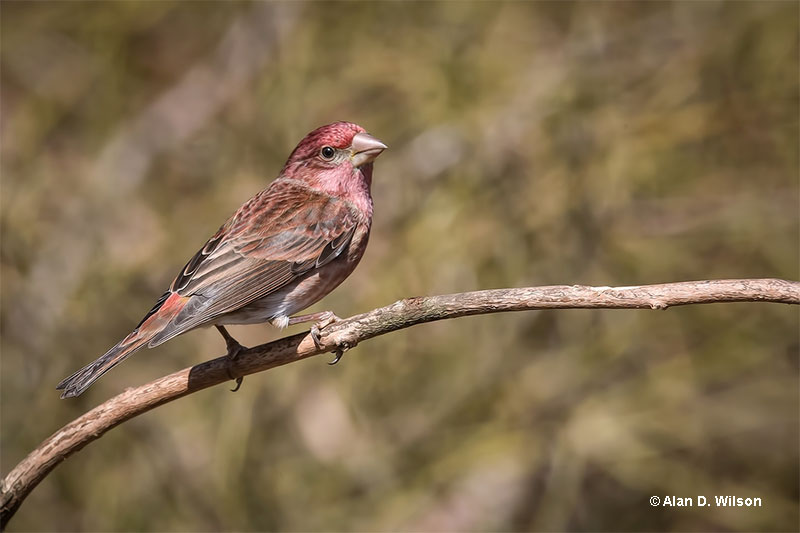
Scientific name: Haemorhous purpureus
Size: 6 inches
Habitat: Coniferous and mixed conifer-deciduous forests and woodlands.
Purple Finches are handsome, sparrow-like birds with notched tails and fairly long wings. Males are beautiful, raspberry-red birds with white on their belly and undertail.
They also have some dark markings on the side of their head and on their back, two pale rose wing bars, and some thick rose streaks on their sides.
Female Purple Finches are heavily streaked, gray-brown birds with a dark patch on their face, pale eyebrow, and a dark mark on each side of their throat.
Related: Tit family (incl. titmice & chickadees)
Purple Finches can visit feeders and occasionally forage on the ground, but we usually see them foraging for seeds in maples or other tall trees.
This species usually occurs in pairs or small flocks and, in winter, can wander around in search of food.
We mostly find Purple Finches in forests and other woodland habitats. However, they can also show up in large parks and in residential areas with big conifers.
Cassin’s Finch
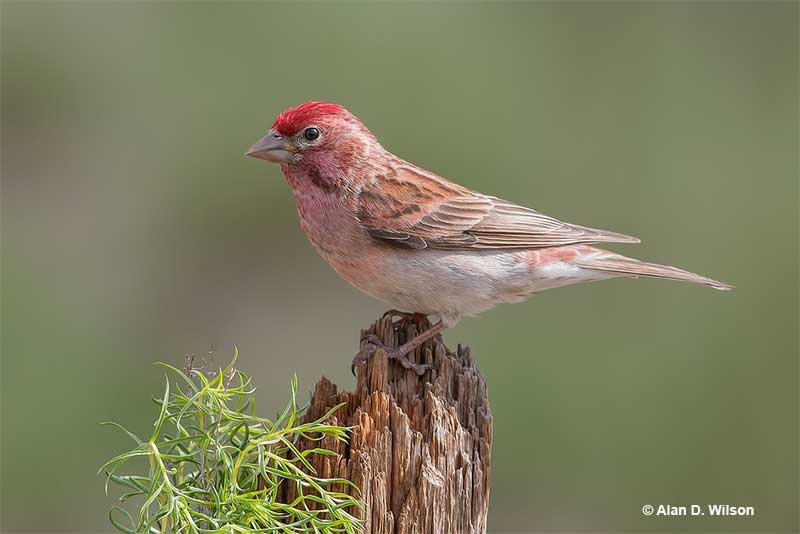
Scientific name: Haemorhous cassinii
Size: 6.25 inches
Habitat: Montane pine and brushy habitats in and near the Rocky Mountains.
The Cassin’s Finch is sparrow-like bird with a sharp, conical beak, and pale markings around its eyes (especially underneath them). It can also show a short pointy crest, has long wings, and a notched tail.
Male Cassin’s Finches are rose-pink with brighter red on their head. They have a white belly and undertail, fine streaks on their sides and undertail, and streaking on the back of their head and back.
Female Cassin’s Finches are gray-brown above and white below with dark streaking above and fine streaking on their head and underparts. They also have two pale wing bars.
We find this local bird in arid montane forests and semi-open habitats. Unlike related species, we rarely seen them at feeders. Instead, they usually occur in pairs or small groups that feed on the ground and in vegetation.
Cassin’s Finches are true birds of the Rocky Mountains. They occur from southern British Columbia to the Mexican highlands.
Gray-crowned Rosy-Finch
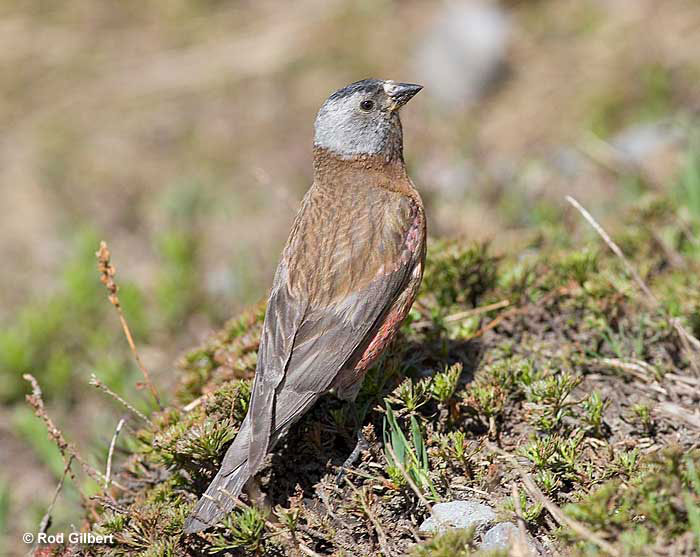
Scientific name: Leucosticte tephrocotis
Size: 6.25 inches
Habitat: Rocky mountains and tundra in the summer and parks and open habitats in the winter.
The Gray-crowned Rosy-Finch is a pretty unique, sparrow-like bird with long wings and a longish, notched tail. They also have black legs, and pale grayish flight feathers.
Male Gray-crowned Rosy-Finches are dark, cinnamon-maroon birds with black and pink wings, and pale gray and black on their heads. They also have a narrow pale eyering, and a black conical beak.
Females have a similar plumage pattern but are duller grayish-brown, have paler pink in their wings, and yellowish beaks.
Like other rosy-finch species, Gray-crowned Rosy-Finches are birds of cold, barren habitats. Flocks forage for small bugs and seeds at the edges of snow fields in rocky areas.
This species occurs in treeless habitats from Alaska to California but can descend to lower elevations in the winter. At that time of the year, it can occur at feeders for excellent, easy views!
Otherwise, seeing one can require a long hike into high mountain habitats.
Black Rosy-Finch
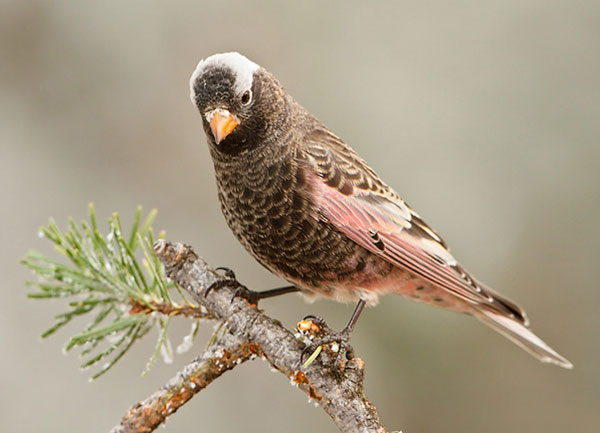
Photograph © Glenn Bartley
Scientific name: Leucosticte atrata
Size: 6.25 inches
Habitat: Montane tundra in the summer, parks and open habitats in the winter.
The Black Rosy-Finch is a beautiful, sparrow-like bird with long, pink and black wings, a longish, notched tail, and black legs.
Male Black Rosy-Finches have a pale gray patch on their coal-black heads, a black conical beak, and a narrow, broken pale eyering. Their bodies are sooty black with some pale gray markings, and they have some dark pink on their bellies.
They also have some dark markings on their white bellies and undertails, and dark streaks on their backs.
Females look like washed out versions of male birds with paler pink in their wings, have more white on their bellies, and yellowish beaks.
Black Rosy-Finches live in rocky, high mountain places. Flocks pick small bugs and seeds from rocks and ground near snow patches.
The Black Rosy-Finch only lives in a small part of the Rocky Mountains. In winter, it does descend to lower elevations and can also occur at feeders for excellent, easy views!
Brown-capped Rosy-Finch
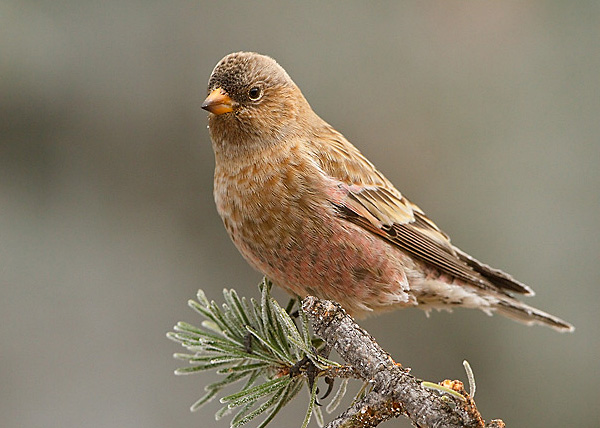
Photograph © Glenn Bartley
Scientific name: Leucosticte australis
Size: 6.25 inches
Habitat: Montane tundra in the summer, parks and open habitats in the winter.
The Brown-capped Rosy-Finch is a handsome, sparrow-like bird with long wings and a notched tail. They have black legs, and pink and black wings.
Male Brown-capped Rosy-Finches are warm brown and rose-colored birds with a dark cap, and a broken, pale eyering. They also have a black conical beak, and some dark markings on their white lower belly and undertail.
Female Brown-capped Rosy-Finches are similar but are much paler gray-brown birds with a yellowish beak. They also have paler pink on their wings, and more white on their bellies.
Like other rosy-finch species, Brown-capped Rosy-Finches live in cold, treeless habitats. Flocks look for small bugs and seeds at the edges of snow fields in Rocky Mountain tundra habitats.
Brown-capped Rosy-Finches breed on cliffs at higher elevations than any other bird north of Mexico. They nest in a very limited area of Colorado and northern New Mexico, and winter at lower elevations, even coming to feeders.
Common Redpoll
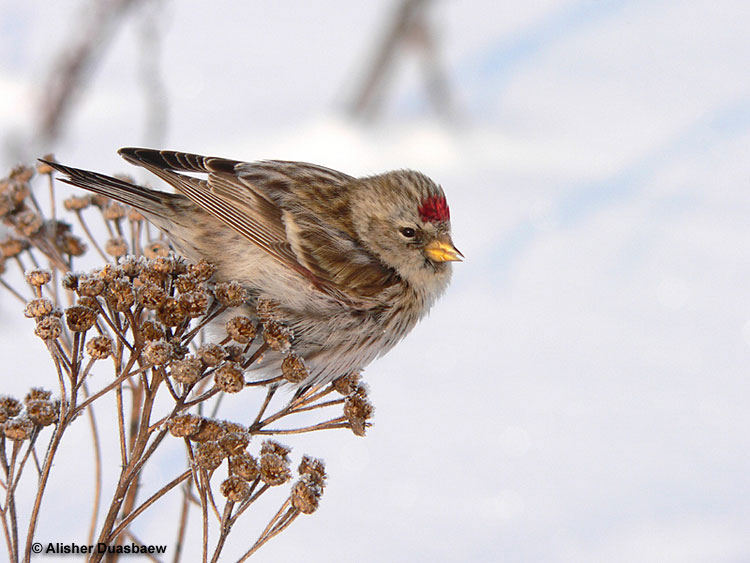
Scientific name: Acanthis flammea
Size: 5.25 inches
Habitat: Brushy, northern subarctic habitats in the summer, weedy fields in the winter.
Common Redpolls are dainty finches with frosty gray and pale brown plumage, and small, yellowish, conical beaks. They have fairly long wings with two white wing bars, and dark notched tails.
They also have a small red patch on their head, a bit of black in front of their eyes and on their throat, and dark streaking on their back and sides.
Male Common Redpolls often have brighter red on their heads than females, and also have a pretty pink wash on their chests.
These small birds occur in flocks, especially in the winter where large numbers can concentrate in weedy fields. They pick small seeds off of stalks but can also forage at backyard feeders.
Common Redpolls don’t occur in woods. They like open areas where they forage on the ground and in low vegetation.
Unless we visit their far northern breeding grounds, we find Common Redpolls wintering in southern Canada and the northern USA.
Hoary Redpoll
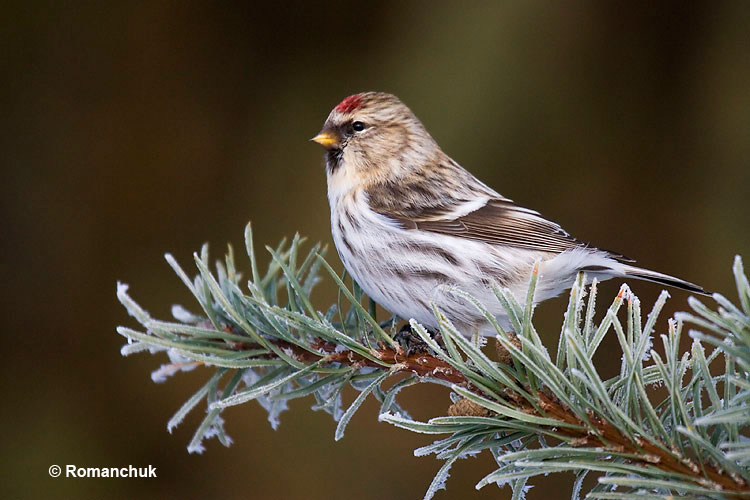
Scientific name: Acanthis hornemanni
Size: 5.5 inches
Habitat: Arctic tundra in the summer, weedy fields in the winter.
Hoary Redpolls are small, pale finches with white and pale brown plumage, and a white rump. They also have very small, yellowish, conical beaks, long wings with two white wing bars, and dark notched tails.
This species has a small red patch on its head, a bit of black in front of its eyes and on the throat, and dark streaking on their back and sides.
Male Hoary Redpolls usually have brighter red on their heads than females, are paler overall, and have a faint pink wash on their chests. Females resemble males but aren’t as pale, and are more streaked.
Hoary Redpolls flock together to forage on small seeds in weedy fields. They use their tiny beaks to pick small seeds off of stalks and the ground. Rarely, they also show up at backyard feeders.
This northern species occurs in tundra and in open grassy habitats only as south as northern Minnesota!
Red Crossbill
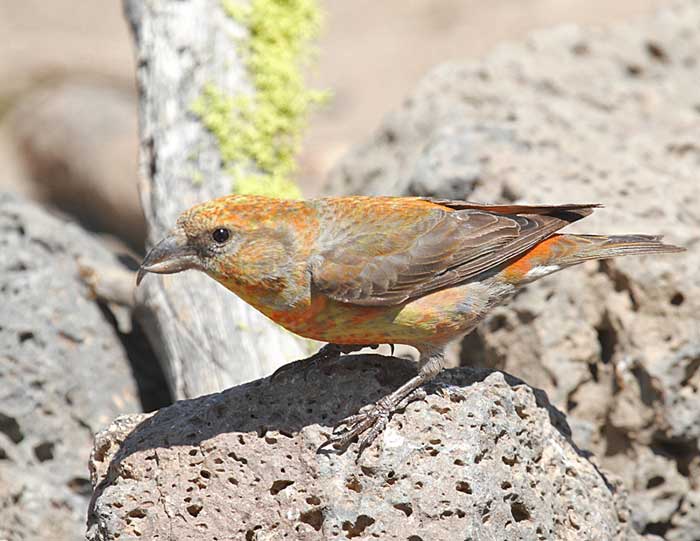
Red Crossbill
Scientific name: Loxia curvirostra
Size: 6.25 inches
Habitat: Northern and montane coniferous forests in the summer, also in other woodlands and park-like habitats with conifers in the winter.
Red Crossbills are sparrow-sized birds that have unique beaks with tips that cross each other. They also have long, dusky wings, a dusky, notched tail, and some gray markings on a pale undertail.
Except for their wings and tails, males are dusky red while females are dull yellow-olive.
The Red Crossbill is a social bird that usually occurs in small flocks. These flocks wander in search of coniferous trees that have seeing cones. When they find the right tree, the crossbills perch and use their distinctive beaks to extract the seeds.
Since Red Crossbills have a unique diet, we don’t see them at feeders. However, they can visit backyards that have big, seeding conifers, especially in the winter months.
In summer, we find Red Crossbills in Alaska, Canada, and parts of the northern and western USA. In winter, they can also occur as far south as Texas and northern Alabama.
Cassia Crossbill

Image credit: Zak Pohlen & Audubon.org
Scientific name: Loxia sinesciuris
Size: 6.25 inches
Habitat: This local species only occurs in Rocky Mountain Lodgepole Pine forests of the South Hills and Albion Mountains in southern Idaho.
Cassia Crosbills are sparrow-sized birds that have deep, unique beaks with tips that cross each other. They also have long, dingy wings, a dusky, notched tail, and some gray markings on their pale undertails. The rest of the male’s plumage is dusky red while females are dull yellow-olive.
This species is a social bird that usually occurs in small flocks and is very similar to the closely related Red Crossbill. However, studies have shown that Cassia Crossbills have distinctive calls, larger beaks, and enough genetic difference to treat them as a separate, unique species.
This species evolved to live in a small area of southern Idaho that lacks Red Squirrels. The lack of squirrels has allowed the crossbill to feed more heavily on the seeds of Lodgepole Pines and evolve a larger beak.
The only way to see them is to travel to their mountain home in southern Idaho. The exact numbers of these finches are unknown, so there is no certain way of telling what their future looks like.
White-winged Crossbill
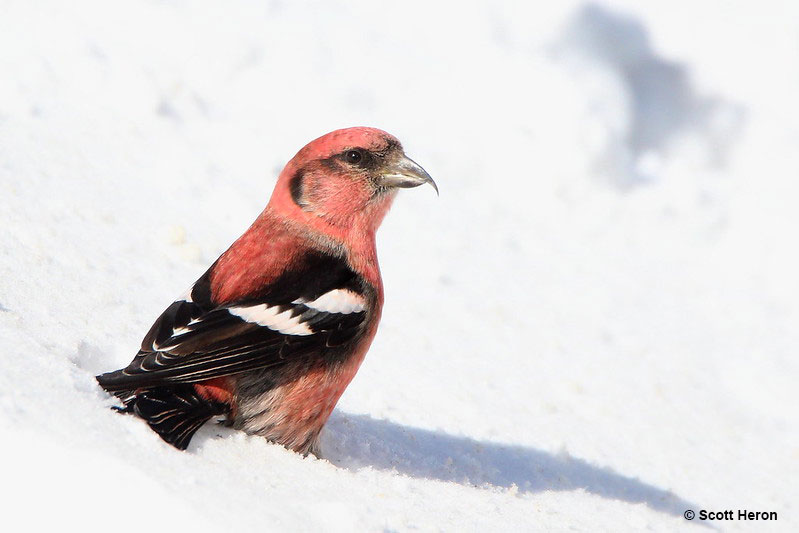
Scientific name: Loxia leucoptera
Size: 6.5 inches
Habitat: Boreal coniferous forests. In winter, they sometimes also occur in park-like habitats with conifers.
White-winged Crossbills are slender, sparrow-sized birds with unique slender beaks that have fine, crossed tips. They also have two, bold white wing bars on long, black wings, and a black, slightly notched tail.
The rest of the male’s plumage is dark pink-red with some gray on their sides and a bit of black in front of their eyes. Females are grayish and dingy yellow with some streaking, while juveniles look like females with heavily streaked plumage.
This species can occur in pairs but is often seen in small flocks in Alaska, Canada, and parts of the northern USA. They roam northern coniferous woodlands in search of seeding larch, hemlock, and spruce trees. When they find the right tree, White-winged Crossbills perch and open the cones with their unique beaks.
Although this species doesn’t come to feeders, in winter, they sometimes visit seeding conifers in the northern USA. On occasion they also roam further south.
Evening Grosbeak
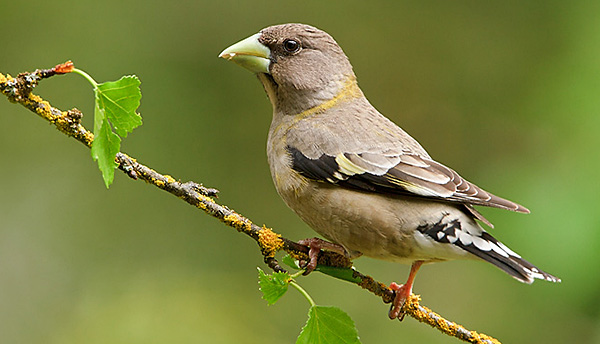
Scientific name: Hesperiphona vespertina
Size: 8 inches
Habitat: Coniferous and montane forests in summer. In winter, they can also occur in other woodlands and park-like habitats.
Evening Grosbeaks are beautiful, chunky finches with huge pale beaks. Males have bright yellow eyebrows on their dark heads, dingy brown-yellow on their backs and chest, and brighter yellow on their belly and lower back.
These finches are similar in size to a European Starling, have a dark, notched tail, and big white patches on their black wings. Females are gray with some yellowish highlights on their nape and sides.
They also have a bit of black in front of their eyes and some white in their wings and tail.
Evening Grosbeaks form flocks that roam woodlands in search of larvae, small fruits, and seeding trees. They feed on a variety of trees, especially maples and Box Elders.
This species occurs in forest habitats in Canada, parts of the northern USA, and the Rocky Mountains. However, in winter, they can also wander to lower elevations and to many parts of the eastern USA. They also visit feeders!
Pine Grosbeak
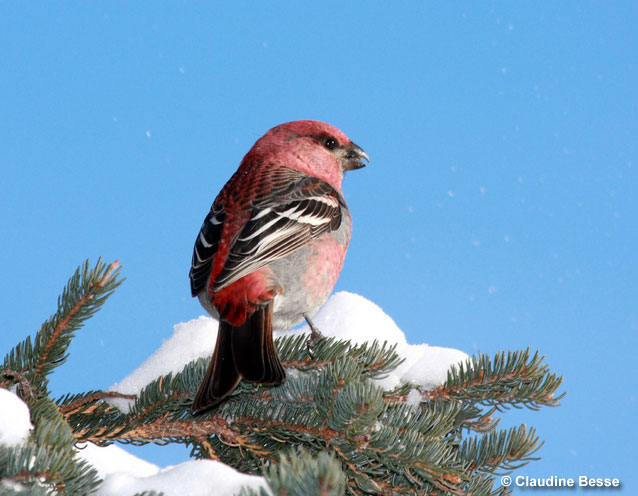
Scientific name: Pinicola enucleator
Size: 9 inches
Habitat: Boreal and high mountain coniferous forests. In winter, sometimes in other woodland and park-like habitats.
Pine Grosbeaks are hefty, robin-sized finches with stubby, curved, almost parrot-like bills. They have fairly long, blackish wings with white edging and two white wing bars, and a long tail.
Male Pine Grosbeaks are raspberry pink-red with gray on their sides, belly, and undertail, and have a bit of black around their eyes and on their backs.
Instead of having red in their plumage, females can have orange-brown or olive on their heads and rump.
Pine Grosbeaks like to eat fruits, conifer needles and buds, and a variety of seeds.
This northern finch occurs as pairs in the summer months but forms small flocks in the winter. In summer, we mostly see them in Alaska, Canada, and montane forests in the western USA.
In winter, Pine Grosbeaks can also migrate to other parts of Canada and the northern USA where they can visit feeders for sunflower seeds and other treats!
Pine Siskin
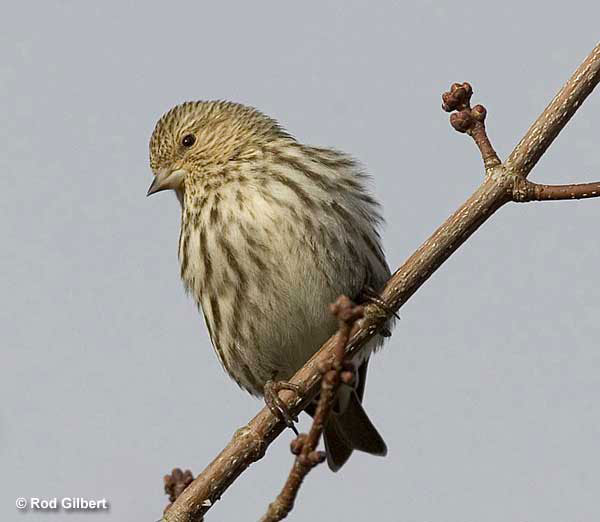
Scientific name: Spinus pinus
Size: 5 inches
Habitat: Coniferous forests in the summer, woodlands, and park-like habitats in the winter.
Pine Siskins are small, streaked, warbler-sized finches with pointed conical beaks. They also have long wings, and short, notched tails.
Males are have lots of gray-brown streaking, one broad yellow wing bar, yellow and pale edging on the rest of its wings, and yellow in their tail.
Females resemble males but lack yellow and have two pale wing bars.
This small finch is very social and can form large flocks of a hundred or more birds, especially during the winter. At all seasons, they feed on the seeds of alder trees and other plants, and also visit feeders.
In summer, we find Pine Siskins in Alaska, Canada, in much of the western USA, and in parts of the northern USA. In winter, they migrate to lower elevations and can reach the southern USA.
However, the numbers of siskins that migrate vary from year to year and depend on food sources in their breeding range.
American Goldfinch

© Alan D. Wilson
Scientific name: Spinus tristis
Size: 5 inches
Habitat: Weedy fields, parks, and meadows.
American Goldfinches are common and beautiful birds in most of the USA and southern Canada. Males are pretty, warbler-sized finches with bright yellow breeding plumage offset by a smart black cap, black wings, and a black and white tail.
They also have a short, pale, conical beak and a white undertail. Female American Goldfinches in summer are yellowish birds with olive-yellow upperparts, and two yellowish wing bars.
In winter, both sexes have pale gray and tan plumage with dark beaks, two yellow wing bars, and pale edging on other feathers in their wings.
These cute birds occur in flocks that visit weedy fields to forage on the seeds of thistle and other meadow plants. They are also regular at feeders, especially in the winter.
We often hear this familiar bird as it flies overhead in bounding flight and makes its “per-chick-ery!” or “potato chip!” call. American Goldfinches like open country but can also visit big backyards.
Lesser Goldfinch
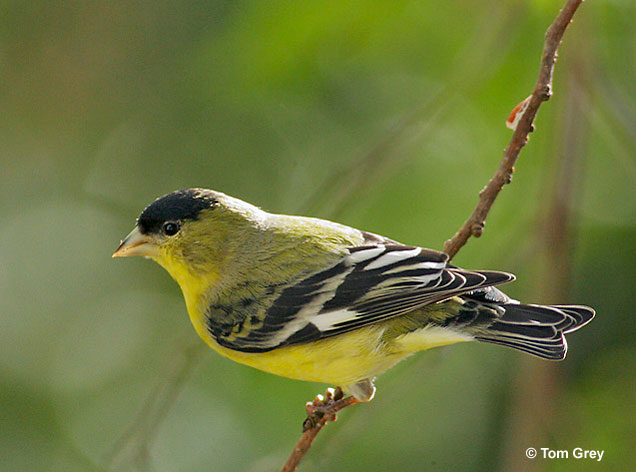
Scientific name: Spinus psaltria
Size: 4.5 inches
Habitat: Brushy habitats, parks, and open woodlands.
Lesser Goldfinches are warbler-sized finches with fair-sized conical beaks and fairly long wings. Males of this smallest finch in North America have yellow underparts with either black upperparts (in Texas), or olive upperparts and a black cap.
They also have a short, notched, black and white tail, and some white markings in their wings including a prominent white patch.
Females are dingier olive-yellow, have a smaller white wing patch, and an all dark tail.
Lesser Goldfinches often occur as pairs but also form flocks, especially in the winter. They roam through brushy and grassy habitats in search of seeding plants and small fruits. They feed on a variety of plants including sunflowers, thistles, mayweed, and coffeeberry.
Lesser Goldfinches pick up food from the ground as well as while perched, and also visit feeders.
We see these pretty little finches in many parts of the western USA, north to parts of western Washington and Wyoming.
Lawrence’s Goldfinch
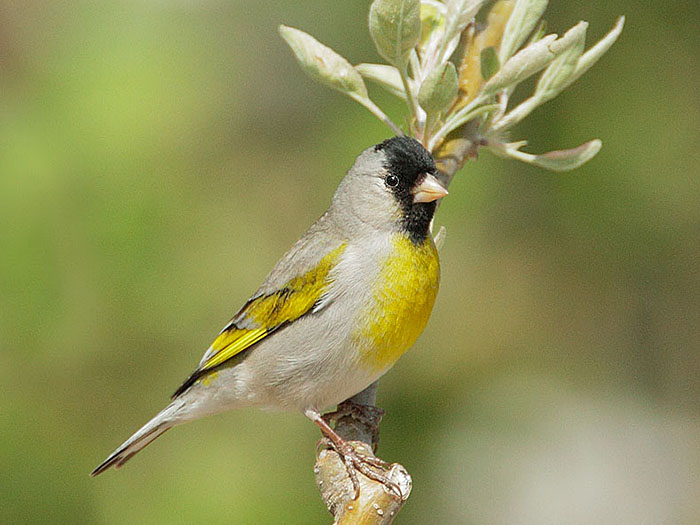
Scientific name: Spinus lawrencei
Size: 4.75 inches
Habitat: Grassy oak savannah in the summer, arid grassland in the winter.
The Lawrence’s Goldfinch is a small, warbler-sized finch restricted to California, Arizona, and adjacent Mexico. This beautiful little bird is mostly pale gray with a small gray conical beak, has long wings, and shows a white band across the underside of its notched tail.
Males have a black cap and face, yellow on their chest, and black and yellow wings. Females are similar but lack black on their heads and tend to only show a bit of yellow in their wings.
Lawrence’s Goldfinches flock with each other birds to feed in meadows and other grassy areas. They eat a variety of seeds especially like Fiddleneck and Pigweed. The birds forage for these and other small seeds by picking them while they are perched and also taking seeds from the ground.
They can also eat mistletoe fruits and other small berries. Although they can visit feeders, they don’t as much as other goldfinch species.


Dan Sansbury
Saturday 20th of April 2024
What about the white-headed finch? We have one at our feeder in Maryland.
Patrick O'Donnell
Monday 22nd of April 2024
@Dan- It's hard to say what that bird might be. There's a good chance it's a bird with leucistic (partially white) plumage.